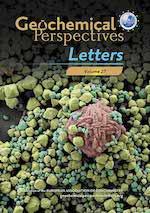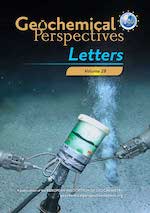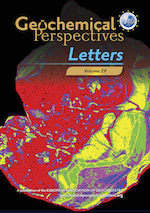Comment on “190Pt-186Os geochronometer reveals open system behaviour of 190Pt-4He isotope system” by Luguet et al. (2019)
Affiliations | Corresponding Author | Cite as | Funding information- Share this article





Article views:1,892Cumulative count of HTML views and PDF downloads.
- Download Citation
- Rights & Permissions
top
Figures
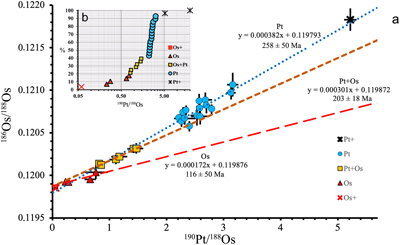 Figure 1 186Os/188Os vs. 190Pt/188Os and 190Pt/188Os probability plot based on the data provided by Luguet et al. (2019) (Table S-2, part 2). The original plot (Fig. 1b in Luguet et al., 2019) is modified by constructing independent regression lines for various mineral types, distinguished by their 190Pt/188Os ratios. Error bars correspond to 1 s.e. Point D-S2 is not shown on the 190Pt/188Os–186Os/188Os plot, as it is off scale. Os+ and Pt+ indicate native osmium and isoferroplatinum, that have significantly different 190Pt/188Os ratios and were excluded from the construction of regression lines in 190Pt/188Os–186Os/188Os coordinates. Ages are calculated in IsoplotR software from a regression line (Vermeesch, 2018). |
| Figure 1 |
top
Comment
Accurate and precise chronology of ore forming processes is critical for the development of genetic models for ore formation. New methods (190Pt-186Os and 190Pt-4He) have been developed recently for determining the timing and complexity of platinum group metal (PGM) mineralisation (e.g., Coggon et al., 2012
Coggon, J. A., Nowell, G.M., Pearson, D.G., Oberthür, T., Lorand, J.P., Melcher, F., Parman, S.W. (2012) The 190Pt-186Os decay system applied to dating platinum-group element mineralization of the Bushveld Complex, South Africa. Chemical Geology 302–303, 48–60.
; Shukolyukov et al., 2012aShukolyukov, Yu.A., Yakubovich, O.V., Mochalov, A.G., Kotov, A.B., Sal’nikova, E.B., Yakovleva, S.Z., Korneev, S.I., Gorokhovskii, B.M. (2012a) New geochronometer for the direct isotopic dating of native platinum minerals (190Pt-4He method). Petrology 20, 491–505.
, Yakubovich et al., 2015Yakubovich, O., Mochalov, A., Kotov, A., Sluzhenikin, S., Okrugin, A., Danisik, M., McDonald, B., Evans, N., McInnes, B. (2015) 190Pt-4He dating of platinum mineralization. Proceedings 13th Biennial SGA Meeting, Nancy 3, 663–664.
). Although these methods are fraternal, both based on the alpha particle decay of 190Pt, the geochemical behaviour of the daughter products (186Os and 4He) contrasts significantly. The combination of these isotope systems for dating single ore mineral phases offers a great opportunity to resolve the timing of ore formation.The first combined study of 190Pt-186Os and 190Pt-4He systems in Pt mineralisation - the Kondyor zoned alkaline-ultramafic complex in the Aldan shield, Russia – has generated a controversial result. Mochalov et al. (2016)
Mochalov, A.G., Yakubovich, O.V., Bortnikov, N.S. (2016) 190Pt–4He age of PGE ores in the alkaline–ultramafic Kondyor massif (Khabarovsk District, Russia). Doklady Earth Sciences 469, 846–850.
obtained 190Pt-4He ages of multiple individual Pt alloy grains to be 112–129 Ma, that was consistent with regional geology, sequence of mineral formation and independent age estimations. Subsequently Luguet et al. (2019)Luguet, A., Nowell, G., Pushkarev, E., Ballhaus, C., Wirth, E., Schreiber, M., Gottman, I. (2019) 190Pt-186Os geochronometer reveals open system behaviour of 190Pt-4He isotope system. Geochemical Perspectives Letters 11, 44–48. https://doi.org/10.7185/geochemlet.1924
reported a 190Pt-186Os isochron age of 240–250 Ma. This age discrepancy led Luguet et al. (2019)Luguet, A., Nowell, G., Pushkarev, E., Ballhaus, C., Wirth, E., Schreiber, M., Gottman, I. (2019) 190Pt-186Os geochronometer reveals open system behaviour of 190Pt-4He isotope system. Geochemical Perspectives Letters 11, 44–48. https://doi.org/10.7185/geochemlet.1924
to conclude that the 190Pt-4He ages of the Pt grains reflected “open system” behaviour, essentially arguing that the radiogenic 4He generated by Pt decay had diffused out of the grains since their formation. This explanation is extremely difficult to reconcile with the experimental low diffusion rate of radiogenic 4He in Pt-Fe alloys (Shukolyukov et al., 2012aShukolyukov, Yu.A., Yakubovich, O.V., Mochalov, A.G., Kotov, A.B., Sal’nikova, E.B., Yakovleva, S.Z., Korneev, S.I., Gorokhovskii, B.M. (2012a) New geochronometer for the direct isotopic dating of native platinum minerals (190Pt-4He method). Petrology 20, 491–505.
,bShukolyukov, Y.A., Yakubovich, O.V., Yakovleva, S.Z., Sal’nikova, E.B., Kotov, A.B., Rytsk, E.Y. (2012b) Geothermochronology based on noble gases: III. Migration of radiogenic He in the crystal structure of native metals with applications to their isotopic dating. Petrology 20, 1–20.
), the retention of extremely high concentrations of cosmogenic 3He by Pt-Fe alloys (Yakubovich et al., 2019Yakubovich, O., Stuart, F.M., Nesterenok, A., Carracedo, A.P. (2019) Cosmogenic 3He in alluvial metal and alloy grains; assessing the potential as a tool for quantifying sediment transport times. Chemical Geology 517, 22–33.
) and with the theory of helium behaviour in metals in general (Trinkaus and Singh, 2003Trinkaus, H., Singh, B.N. (2003) Helium accumulation in metals during irradiation–where do we stand? Journal of Nuclear Materials 323, 229–242.
). Herein we provide an alternative point of view on the discrepancy between 190Pt-4He and 190Pt-186Os systems in Pt alloys of the Kondyor alkaline-ultramafic complex.There is abundant independent radiometric geochronological age that the Kondyor ultramafic massif and the associated PGM mineralisation has an Early Cretaceous age; Sm-Nd, Rb-Sr, 40Ar-39Ar, baddeleyite U-Pb ages are in the range 120–132 Ma (Table S-1). These ages are essentially consistent within measurement uncertainty. These isotope systems have closure temperatures that range from ∼300 °C (biotite Ar-Ar; Harrison et al., 1985
Harrison, T.M., Duncan, I., McDougall, I. (1985) Diffusion of 40Ar in biotite: temperature, pressure and compositional effects. Geochimica et Cosmochimica Acta 49, 2461–2468.
) to over 1150 °C (clinopyroxene Sm-Nd; Van Orman et al., 2001Van Orman, J.A., Grove, T.L., Shimizu, N. (2001) Rare earth element diffusion in diopside: influence of temperature, pressure, and ionic radius, and an elastic model for diffusion in silicates. Contributions to Mineralogy and Petrology 141, 687–703.
), implying that Pt mineralisation was simultaneous with intrusion, and that post-intrusion cooling of the complex was instantaneous, within our ability to resolve it.Luguet et al. (2019)
Luguet, A., Nowell, G., Pushkarev, E., Ballhaus, C., Wirth, E., Schreiber, M., Gottman, I. (2019) 190Pt-186Os geochronometer reveals open system behaviour of 190Pt-4He isotope system. Geochemical Perspectives Letters 11, 44–48. https://doi.org/10.7185/geochemlet.1924
have ignored the evidence for the Cretaceous age of alkaline magmatic complexes, and associated ore deposits, in the Aldan shield region (Yarmolyuk et al., 2019Yarmolyuk, V.V., Nikiforov, A.V., Kozlovsky, A.M., Kudryashova, E.A. (2019) Late Mesozoic East Asian magmatic province: Structure, magmatic signature, formation conditions. Geotectonics 53, 500–516.
and references therein). In support of the Early Triassic age of the Kondyor ultramafic complex they remark on the similarity with detrital zircon grains from the Lena river and Mohe-Upper Amur basin. These rivers are 800–1500 km from the Kondyor ultramafic massif, and the detrital zircons are generally accepted to originate in the Angaro-Vitim batholiths and the China craton (Wang et al., 2011Wang, C.Y., Campbell, I.H., Stepanov, A.S., Allen, C.M., Burtsev, I.N. (2011) Growth rate of the preserved continental crust: II. Constraints from Hf and O isotopes in detrital zircons from Greater Russian Rivers. Geochimica et Cosmochimica Acta 75, 1308–1345.
; Miller et al., 2013Miller, E.L., Soloviev, A.V., Prokopiev, A.V., Toro, J., Harris, D., Kuzmichev, A.B., Gehrels, G.E. (2013) Triassic river systems and the paleo-Pacific margin of northwestern Pangea. Gondwana Research 23, 1631–1645.
; Guo et al., 2017Guo, Z.X., Yong, T.Y., Zyabrev, S., Zhen, H.H. (2017) Tectonostratigraphic evolution of the Mohe-Upper Amur Basin reflects the final closure of the Mongol-Okhotsk Ocean in the latest Jurassic–earliest Cretaceous. Journal of Asian Earth Sciences 145, 494–511.
) rather than the Aldan shield.The Luguet et al. (2019)
Luguet, A., Nowell, G., Pushkarev, E., Ballhaus, C., Wirth, E., Schreiber, M., Gottman, I. (2019) 190Pt-186Os geochronometer reveals open system behaviour of 190Pt-4He isotope system. Geochemical Perspectives Letters 11, 44–48. https://doi.org/10.7185/geochemlet.1924
study failed to put the study material into context. The formation of platinum mineralisation within the Kondyor massif was polycyclic (Mochalov, 2019Mochalov, A.G. (2019) Platinum minerals of Konder. Mineralogical Almanac 23, 128p.
). Cumulate dunites, the earliest rocks of the massif, underwent syn-magmatic recrystallisation and metasomatic transformation under the influence of ultramafic, mafic, alkaline, and granitoid intrusions. This resulted in the formation of five genetically distinct types of PGMs. The Pt alloys analysed by Luguet et al. (2019)Luguet, A., Nowell, G., Pushkarev, E., Ballhaus, C., Wirth, E., Schreiber, M., Gottman, I. (2019) 190Pt-186Os geochronometer reveals open system behaviour of 190Pt-4He isotope system. Geochemical Perspectives Letters 11, 44–48. https://doi.org/10.7185/geochemlet.1924
belong to the later generations of PGM that were formed due to the recrystallisation and remobilisation of earlier PGM at temperatures not higher than 650–850 °C (see Supplementary Information; Table S-2). This indicates that the PGE chemistry of fluids that were responsible for the formation of these Pt alloys evolved with time. It also indicates that the age of Pt alloys is coeval with the emplacement of Kondyor massif. Thus, there is no evidence for the crystallisation of these Pt alloys in a root of an Early Triassic volcano that was exhumated in Early Cretaceous time, as proposed by Luguet et al. (2019)Luguet, A., Nowell, G., Pushkarev, E., Ballhaus, C., Wirth, E., Schreiber, M., Gottman, I. (2019) 190Pt-186Os geochronometer reveals open system behaviour of 190Pt-4He isotope system. Geochemical Perspectives Letters 11, 44–48. https://doi.org/10.7185/geochemlet.1924
.Figure 1 shows the Pt-Os data sample 1265 obtained by Luguet et al. (2019
Luguet, A., Nowell, G., Pushkarev, E., Ballhaus, C., Wirth, E., Schreiber, M., Gottman, I. (2019) 190Pt-186Os geochronometer reveals open system behaviour of 190Pt-4He isotope system. Geochemical Perspectives Letters 11, 44–48. https://doi.org/10.7185/geochemlet.1924
; Table S-2, part 2). There is significant variation in 190Pt/188Os and 186Os/188Os ratios. Based on 190Pt/188Os ratio the samples studied by Luguet et al. (2019)Luguet, A., Nowell, G., Pushkarev, E., Ballhaus, C., Wirth, E., Schreiber, M., Gottman, I. (2019) 190Pt-186Os geochronometer reveals open system behaviour of 190Pt-4He isotope system. Geochemical Perspectives Letters 11, 44–48. https://doi.org/10.7185/geochemlet.1924
fall into several mineral types; native osmium (Os, Os+), aggregates and crypto-aggregates of native osmium with isoferroplatinum (Pt + Os) and isoferroplatinum (Pt, Pt+) (Fig. 1b). The regression line in 190Pt/188Os and 186Os/188Os space for each of these mineral types have different and distinct slopes (Fig. 1a). Ontogeny of the minerals show that native osmium crystallised before the Pt alloys (see Fig. 1 in Luguet et al., 2019Luguet, A., Nowell, G., Pushkarev, E., Ballhaus, C., Wirth, E., Schreiber, M., Gottman, I. (2019) 190Pt-186Os geochronometer reveals open system behaviour of 190Pt-4He isotope system. Geochemical Perspectives Letters 11, 44–48. https://doi.org/10.7185/geochemlet.1924
). This implies heterogeneity in primary 186Os/188Os composition, which is accompanied by systematic differences in the 190Pt/188Os ratio (Fig. 1b). Thus, the regression line in 190Pt/188Os and 186Os/188Os space through all the data (Fig. 2b in Luguet et al., 2019Luguet, A., Nowell, G., Pushkarev, E., Ballhaus, C., Wirth, E., Schreiber, M., Gottman, I. (2019) 190Pt-186Os geochronometer reveals open system behaviour of 190Pt-4He isotope system. Geochemical Perspectives Letters 11, 44–48. https://doi.org/10.7185/geochemlet.1924
) is not an isochron, and therefore provides no age information. The obvious disturbance of 187Re-187Os isotope system within the same grains (Fig. 2a in Luguet et al., 2019Luguet, A., Nowell, G., Pushkarev, E., Ballhaus, C., Wirth, E., Schreiber, M., Gottman, I. (2019) 190Pt-186Os geochronometer reveals open system behaviour of 190Pt-4He isotope system. Geochemical Perspectives Letters 11, 44–48. https://doi.org/10.7185/geochemlet.1924
) directly confirms this.
Figure 1 186Os/188Os vs. 190Pt/188Os and 190Pt/188Os probability plot based on the data provided by Luguet et al. (2019)
Luguet, A., Nowell, G., Pushkarev, E., Ballhaus, C., Wirth, E., Schreiber, M., Gottman, I. (2019) 190Pt-186Os geochronometer reveals open system behaviour of 190Pt-4He isotope system. Geochemical Perspectives Letters 11, 44–48. https://doi.org/10.7185/geochemlet.1924
(Table S-2, part 2). The original plot (Fig. 1b in Luguet et al., 2019Luguet, A., Nowell, G., Pushkarev, E., Ballhaus, C., Wirth, E., Schreiber, M., Gottman, I. (2019) 190Pt-186Os geochronometer reveals open system behaviour of 190Pt-4He isotope system. Geochemical Perspectives Letters 11, 44–48. https://doi.org/10.7185/geochemlet.1924
) is modified by constructing independent regression lines for various mineral types, distinguished by their 190Pt/188Os ratios. Error bars correspond to 1 s.e. Point D-S2 is not shown on the 190Pt/188Os–186Os/188Os plot, as it is off scale. Os+ and Pt+ indicate native osmium and isoferroplatinum, that have significantly different 190Pt/188Os ratios and were excluded from the construction of regression lines in 190Pt/188Os–186Os/188Os coordinates. Ages are calculated in IsoplotR software from a regression line (Vermeesch, 2018Vermeesch, P. (2018) IsoplotR: A free and open toolbox for geochronology. Geoscience Frontiers 9, 1479–1493.
).In summary, the data provided by Luguet et al. (2019)
Luguet, A., Nowell, G., Pushkarev, E., Ballhaus, C., Wirth, E., Schreiber, M., Gottman, I. (2019) 190Pt-186Os geochronometer reveals open system behaviour of 190Pt-4He isotope system. Geochemical Perspectives Letters 11, 44–48. https://doi.org/10.7185/geochemlet.1924
do not show any evidence for open 190Pt-4He system behaviour. Nor does it provide any support for an Early Triassic age of the Kondyor massif. The discrepancy between 190Pt-4He and 190Pt-186Os ages of the Pt alloys of the Kondyor massif reflect contrasting geochemical behaviour of daughter isotopes during the polycyclic formation of platinum mineralisation. 190Pt-4He age reflects the age of mineral formation itself, while the 190Pt-186Os isotope system fingerprints earlier redistribution of PGE. Luguet et al. (2019)Luguet, A., Nowell, G., Pushkarev, E., Ballhaus, C., Wirth, E., Schreiber, M., Gottman, I. (2019) 190Pt-186Os geochronometer reveals open system behaviour of 190Pt-4He isotope system. Geochemical Perspectives Letters 11, 44–48. https://doi.org/10.7185/geochemlet.1924
have established a number of remarkable features of the behaviour of the Pt and Os isotopes in PGM grains. If such phenomena are present in other ore occurrences in the other ultramafic massifs (mantle, island arc, shield) they will surely provide a number of significant additions to the mineralogy of the PGE and geochemistry of HSE in general.top
Acknowledgements
The authors are grateful to A.V. Ivanov and A.B. Kotov for valuable discussion. This research was supported by RTD of IPGG RAS (FMUW-2022-0004; FMUW-2022-0003) and SUERC.
Editor: Cin-Ty Lee
top
References
Coggon, J. A., Nowell, G.M., Pearson, D.G., Oberthür, T., Lorand, J.P., Melcher, F., Parman, S.W. (2012) The 190Pt-186Os decay system applied to dating platinum-group element mineralization of the Bushveld Complex, South Africa. Chemical Geology 302–303, 48–60. https://doi.org/10.1016/j.chemgeo.2011.10.015
 Show in context
Show in context New methods (190Pt-186Os and 190Pt-4He) have been developed recently for determining the timing and complexity of platinum group metal (PGM) mineralisation (e.g., Coggon et al., 2012; Shukolyukov et al., 2012a, Yakubovich et al., 2015).
View in article
Guo, Z.X., Yong, T.Y., Zyabrev, S., Zhen, H.H. (2017) Tectonostratigraphic evolution of the Mohe-Upper Amur Basin reflects the final closure of the Mongol-Okhotsk Ocean in the latest Jurassic–earliest Cretaceous. Journal of Asian Earth Sciences 145, 494–511. https://doi.org/10.1016/j.jseaes.2017.06.020
 Show in context
Show in context These rivers are 800–1500 km from the Kondyor ultramafic massif, and the detrital zircons are generally accepted to originate in the Angaro-Vitim batholiths and the China craton (Wang et al., 2011; Miller et al., 2013; Guo et al., 2017) rather than the Aldan shield.
View in article
Harrison, T.M., Duncan, I., McDougall, I. (1985) Diffusion of 40Ar in biotite: temperature, pressure and compositional effects. Geochimica et Cosmochimica Acta 49, 2461–2468. https://doi.org/10.1016/0016-7037(85)90246-7
 Show in context
Show in context These ages are essentially consistent within measurement uncertainty. These isotope systems have closure temperatures that range from ∼300 °C (biotite Ar-Ar; Harrison et al., 1985) to over 1150 °C (clinopyroxene Sm-Nd; Van Orman et al., 2001), implying that Pt mineralisation was simultaneous with intrusion, and that post-intrusion cooling of the complex was instantaneous, within our ability to resolve it.
View in article
Luguet, A., Nowell, G., Pushkarev, E., Ballhaus, C., Wirth, E., Schreiber, M., Gottman, I. (2019) 190Pt-186Os geochronometer reveals open system behaviour of 190Pt-4He isotope system. Geochemical Perspectives Letters 11, 44–48. https://doi.org/10.7185/geochemlet.1924
 Show in context
Show in context Subsequently Luguet et al. (2019) reported a 190Pt-186Os isochron age of 240–250 Ma. This age discrepancy led Luguet et al. (2019) to conclude that the 190Pt-4He ages of the Pt grains reflected “open system” behaviour, essentially arguing that the radiogenic 4He generated by Pt decay had diffused out of the grains since their formation.
View in article
Luguet et al. (2019) have ignored the evidence for the Cretaceous age of alkaline magmatic complexes, and associated ore deposits, in the Aldan shield region (Yarmolyuk et al., 2019 and references therein).
View in article
The Luguet et al. (2019) study failed to put the study material into context. The formation of platinum mineralisation within the Kondyor massif was polycyclic (Mochalov, 2019).
View in article
This resulted in the formation of five genetically distinct types of PGMs. The Pt alloys analysed by Luguet et al. (2019) belong to the later generations of PGM that were formed due to the recrystallisation and remobilisation of earlier PGM at temperatures not higher than 650–850 °C (see
View in article
Thus, there is no evidence for the crystallisation of these Pt alloys in a root of an Early Triassic volcano that was exhumated in Early Cretaceous time, as proposed by Luguet et al. (2019).
View in article
Figure 1 shows the Pt-Os data sample 1265 obtained by Luguet et al. (2019; Table S-2, part 2).
View in article
Based on 190Pt/188Os ratio the samples studied by Luguet et al. (2019) fall into several mineral types; native osmium (Os, Os+), aggregates and crypto-aggregates of native osmium with isoferroplatinum (Pt + Os) and isoferroplatinum (Pt, Pt+) (Fig. 1b).
View in article
Ontogeny of the minerals show that native osmium crystallised before the Pt alloys (see Fig. 1 in Luguet et al., 2019).
View in article
Thus, the regression line in 190Pt/188Os and 186Os/188Os space through all the data (Fig. 2b in Luguet et al., 2019) is not an isochron, and therefore provides no age information.
View in article
The obvious disturbance of 187Re-187Os isotope system within the same grains (Fig. 2a in Luguet et al., 2019) directly confirms this.
View in article
186Os/188Os vs. 190Pt/188Os and 190Pt/188Os probability plot based on the data provided by Luguet et al. (2019) (Table S-2, part 2).
View in article
The original plot (Fig. 1b in Luguet et al., 2019) is modified by constructing independent regression lines for various mineral types, distinguished by their 190Pt/188Os ratios. Error bars correspond to 1 s.e.
View in article
In summary, the data provided by Luguet et al. (2019) do not show any evidence for open 190Pt-4He system behaviour.
View in article
Luguet et al. (2019) have established a number of remarkable features of the behaviour of the Pt and Os isotopes in PGM grains.
View in article
Subsequently Luguet et al. (2019) reported a 190Pt-186Os isochron age of 240–250 Ma. This age discrepancy led Luguet et al. (2019) to conclude that the 190Pt-4He ages of the Pt grains reflected “open system” behaviour, essentially arguing that the radiogenic 4He generated by Pt decay had diffused out of the grains since their formation.
View in article
Miller, E.L., Soloviev, A.V., Prokopiev, A.V., Toro, J., Harris, D., Kuzmichev, A.B., Gehrels, G.E. (2013) Triassic river systems and the paleo-Pacific margin of northwestern Pangea. Gondwana Research 23, 1631–1645. https://doi.org/10.1016/j.gr.2012.08.015
 Show in context
Show in context These rivers are 800–1500 km from the Kondyor ultramafic massif, and the detrital zircons are generally accepted to originate in the Angaro-Vitim batholiths and the China craton (Wang et al., 2011; Miller et al., 2013; Guo et al., 2017) rather than the Aldan shield.
View in article
Mochalov, A.G. (2019) Platinum minerals of Konder. Mineralogical Almanac 23, 128p.
 Show in context
Show in context The Luguet et al. (2019) study failed to put the study material into context. The formation of platinum mineralisation within the Kondyor massif was polycyclic (Mochalov, 2019).
View in article
Mochalov, A.G., Yakubovich, O.V., Bortnikov, N.S. (2016) 190Pt–4He age of PGE ores in the alkaline–ultramafic Kondyor massif (Khabarovsk District, Russia). Doklady Earth Sciences 469, 846–850. https://doi.org/10.1134/S1028334X16080134
 Show in context
Show in context Mochalov et al. (2016) obtained 190Pt-4He ages of multiple individual Pt alloy grains to be 112–129 Ma, that was consistent with regional geology, sequence of mineral formation and independent age estimations.
View in article
Shukolyukov, Yu.A., Yakubovich, O.V., Mochalov, A.G., Kotov, A.B., Sal’nikova, E.B., Yakovleva, S.Z., Korneev, S.I., Gorokhovskii, B.M. (2012a) New geochronometer for the direct isotopic dating of native platinum minerals (190Pt-4He method). Petrology 20, 491–505. https://doi.org/10.1134/S0869591112060033
 Show in context
Show in context This explanation is extremely difficult to reconcile with the experimental low diffusion rate of radiogenic 4He in Pt-Fe alloys (Shukolyukov et al., 2012a,b), the retention of extremely high concentrations of cosmogenic 3He by Pt-Fe alloys (Yakubovich et al., 2019) and with the theory of helium behaviour in metals in general (Trinkaus and Singh, 2003).
View in article
New methods (190Pt-186Os and 190Pt-4He) have been developed recently for determining the timing and complexity of platinum group metal (PGM) mineralisation (e.g., Coggon et al., 2012; Shukolyukov et al., 2012a, Yakubovich et al., 2015).
View in article
Shukolyukov, Y.A., Yakubovich, O.V., Yakovleva, S.Z., Sal’nikova, E.B., Kotov, A.B., Rytsk, E.Y. (2012b) Geothermochronology based on noble gases: III. Migration of radiogenic He in the crystal structure of native metals with applications to their isotopic dating. Petrology 20, 1–20. https://doi.org/10.1134/S0869591112010043
 Show in context
Show in context This explanation is extremely difficult to reconcile with the experimental low diffusion rate of radiogenic 4He in Pt-Fe alloys (Shukolyukov et al., 2012a,b), the retention of extremely high concentrations of cosmogenic 3He by Pt-Fe alloys (Yakubovich et al., 2019) and with the theory of helium behaviour in metals in general (Trinkaus and Singh, 2003).
View in article
Trinkaus, H., Singh, B.N. (2003) Helium accumulation in metals during irradiation–where do we stand? Journal of Nuclear Materials 323, 229–242. https://doi.org/10.1016/j.jnucmat.2003.09.001
 Show in context
Show in context This explanation is extremely difficult to reconcile with the experimental low diffusion rate of radiogenic 4He in Pt-Fe alloys (Shukolyukov et al., 2012a,b), the retention of extremely high concentrations of cosmogenic 3He by Pt-Fe alloys (Yakubovich et al., 2019) and with the theory of helium behaviour in metals in general (Trinkaus and Singh, 2003).
View in article
Van Orman, J.A., Grove, T.L., Shimizu, N. (2001) Rare earth element diffusion in diopside: influence of temperature, pressure, and ionic radius, and an elastic model for diffusion in silicates. Contributions to Mineralogy and Petrology 141, 687–703. https://doi.org/10.1007/s004100100269
 Show in context
Show in context These ages are essentially consistent within measurement uncertainty. These isotope systems have closure temperatures that range from ∼300 °C (biotite Ar-Ar; Harrison et al., 1985) to over 1150 °C (clinopyroxene Sm-Nd; Van Orman et al., 2001), implying that Pt mineralisation was simultaneous with intrusion, and that post-intrusion cooling of the complex was instantaneous, within our ability to resolve it.
View in article
Vermeesch, P. (2018) IsoplotR: A free and open toolbox for geochronology. Geoscience Frontiers 9, 1479–1493. https://doi.org/10.1016/j.gsf.2018.04.001
 Show in context
Show in context Ages are calculated in IsoplotR software from a regression line (Vermeesch, 2018).
View in article
Wang, C.Y., Campbell, I.H., Stepanov, A.S., Allen, C.M., Burtsev, I.N. (2011) Growth rate of the preserved continental crust: II. Constraints from Hf and O isotopes in detrital zircons from Greater Russian Rivers. Geochimica et Cosmochimica Acta 75, 1308–1345. https://doi.org/10.1016/j.gca.2010.12.010
 Show in context
Show in context These rivers are 800–1500 km from the Kondyor ultramafic massif, and the detrital zircons are generally accepted to originate in the Angaro-Vitim batholiths and the China craton (Wang et al., 2011; Miller et al., 2013; Guo et al., 2017) rather than the Aldan shield.
View in article
Yakubovich, O., Mochalov, A., Kotov, A., Sluzhenikin, S., Okrugin, A., Danisik, M., McDonald, B., Evans, N., McInnes, B. (2015) 190Pt-4He dating of platinum mineralization. Proceedings 13th Biennial SGA Meeting, Nancy 3, 663–664.
 Show in context
Show in context New methods (190Pt-186Os and 190Pt-4He) have been developed recently for determining the timing and complexity of platinum group metal (PGM) mineralisation (e.g., Coggon et al., 2012; Shukolyukov et al., 2012a, Yakubovich et al., 2015).
View in article
Yakubovich, O., Stuart, F.M., Nesterenok, A., Carracedo, A.P. (2019) Cosmogenic 3He in alluvial metal and alloy grains; assessing the potential as a tool for quantifying sediment transport times. Chemical Geology 517, 22–33. https://doi.org/10.1016/j.chemgeo.2019.04.010
 Show in context
Show in context This explanation is extremely difficult to reconcile with the experimental low diffusion rate of radiogenic 4He in Pt-Fe alloys (Shukolyukov et al., 2012a,b), the retention of extremely high concentrations of cosmogenic 3He by Pt-Fe alloys (Yakubovich et al., 2019) and with the theory of helium behaviour in metals in general (Trinkaus and Singh, 2003).
View in article
Yarmolyuk, V.V., Nikiforov, A.V., Kozlovsky, A.M., Kudryashova, E.A. (2019) Late Mesozoic East Asian magmatic province: Structure, magmatic signature, formation conditions. Geotectonics 53, 500–516. https://doi.org/10.1134/S0016852119040071
 Show in context
Show in context Luguet et al. (2019) have ignored the evidence for the Cretaceous age of alkaline magmatic complexes, and associated ore deposits, in the Aldan shield region (Yarmolyuk et al., 2019 and references therein).
View in article
top
Supplementary Information
The Supplementary Information includes:
- 1. General Remarks on Retentivity of Radiogenic Helium in Pt-alloys
- 2. Summary of Previous Geochronology for the Kondyor Massif
- 3. General Remarks on Pt Mineralisation of the Kondyor Massif
- Tables S-1 and S-2
- Supplementary Information References
Download the Supplementary Information (PDF).
top
Figures
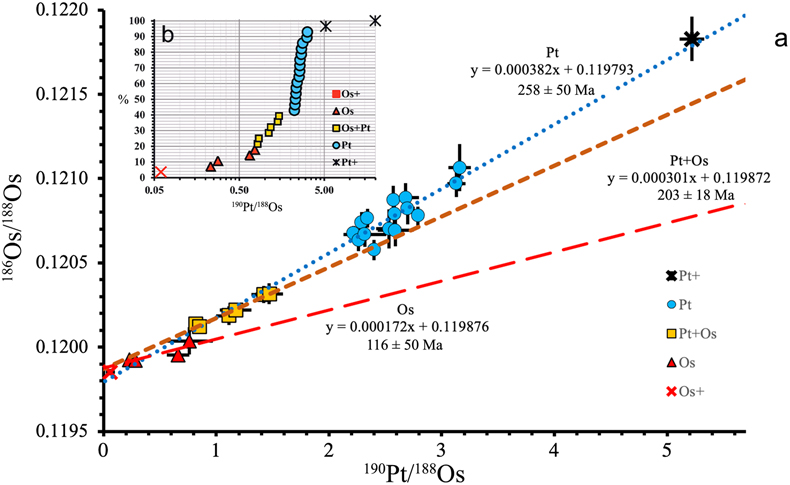
Figure 1 186Os/188Os vs. 190Pt/188Os and 190Pt/188Os probability plot based on the data provided by Luguet et al. (2019)
Luguet, A., Nowell, G., Pushkarev, E., Ballhaus, C., Wirth, E., Schreiber, M., Gottman, I. (2019) 190Pt-186Os geochronometer reveals open system behaviour of 190Pt-4He isotope system. Geochemical Perspectives Letters 11, 44–48. https://doi.org/10.7185/geochemlet.1924
(Table S-2, part 2). The original plot (Fig. 1b in Luguet et al., 2019Luguet, A., Nowell, G., Pushkarev, E., Ballhaus, C., Wirth, E., Schreiber, M., Gottman, I. (2019) 190Pt-186Os geochronometer reveals open system behaviour of 190Pt-4He isotope system. Geochemical Perspectives Letters 11, 44–48. https://doi.org/10.7185/geochemlet.1924
) is modified by constructing independent regression lines for various mineral types, distinguished by their 190Pt/188Os ratios. Error bars correspond to 1 s.e. Point D-S2 is not shown on the 190Pt/188Os–186Os/188Os plot, as it is off scale. Os+ and Pt+ indicate native osmium and isoferroplatinum, that have significantly different 190Pt/188Os ratios and were excluded from the construction of regression lines in 190Pt/188Os–186Os/188Os coordinates. Ages are calculated in IsoplotR software from a regression line (Vermeesch, 2018Vermeesch, P. (2018) IsoplotR: A free and open toolbox for geochronology. Geoscience Frontiers 9, 1479–1493.
).

